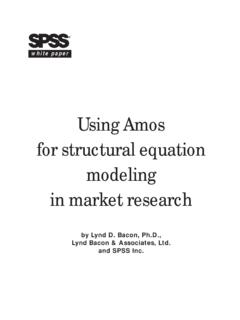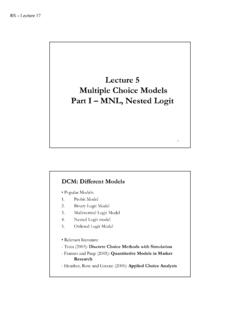Transcription of CHAPTER I FOREIGN EXCHANGE MARKETS I. Introduction to …
1 I FOREIGN EXCHANGE MARKETS The international business context requires trading and investing in assets denominated in different currencies. FOREIGN assets and liabilities add a new dimension to the risk profile of a firm or an investor's portfolio: FOREIGN EXCHANGE risk. This CHAPTER has two goals. First, this CHAPTER introduces the terminology used in FOREIGN EXCHANGE MARKETS . Second, this CHAPTER presents the instruments used in currency MARKETS . I. Introduction to the FOREIGN EXCHANGE Market An EXCHANGE Rate is Just a Price The FOREIGN EXCHANGE (FX or FOREX) market is the market where EXCHANGE rates are determined. EXCHANGE rates are the mechanisms by which world currencies are tied together in the global marketplace, providing the price of one currency in terms of another. An EXCHANGE rate is a price, specifically the relative price of two currencies. For example, the dollar/Mexican peso EXCHANGE rate is the price of a peso expressed in dollars.
2 On March 23, 2015, this EXCHANGE rate was USD per EUR, or, in market notation, USD/EUR. The Price of Milk and the Price of FOREIGN Currency An EXCHANGE rate is another price in the economy. Let s compare an EXCHANGE rate to the price of milk. Suppose that the price of a gallon of milk is USD , or USD/milk, using the above EXCHANGE rate market notation. When we price milk, the denominator refers to one unit of the good that it is being bought a gallon of milk. When we price EXCHANGE rates, the denominator refers specifically to one unit of a currency. Therefore, think of the currency in the denominator as the currency you are buying. The EXCHANGE rate is just a price, but it is an important one: St plays a very important role in the economy since it directly influences imports, exports, & cross-border investments. It has an indirect effect on other economic variables, such as the domestic price level, Pd, and real wages.
3 For example: when St increases, FOREIGN imports become more expensive in USD. Then, the domestic price level Pd increases and, thus, real wages decrease (through a reduction in purchasing power). Also, when St increases, USD-denominated goods and assets are more affordable to foreigners. Foreigners buy more goods and assets in the (exports, real estate, bonds, companies, etc.). These factors drive aggregate demand up and, thus, GDP increases. Equilibrium EXCHANGE Rates and FOREIGN EXCHANGE Risk Like in any other market, demand and supply determine the price of a currency. At any point in time, in a given country, the EXCHANGE rate is determined by the interaction of the demand for FOREIGN currency and the corresponding supply of FOREIGN currency. Thus, the EXCHANGE rate is an equilibrium price (StE) determined by supply and demand considerations, as shown by Exhibit Exhibit Demand and Supply determine the price of FOREIGN currency (StE).
4 St Supply of FC (S) StE Demand of FC (D) Quantity of FC What are the determinants of currency supply and demand in the FOREIGN EXCHANGE market? The supply of FOREIGN currency derives from FOREIGN residents purchasing domestic goods and services domestic export--, FOREIGN investors purchasing domestic assets, and FOREIGN tourists traveling to the domestic country. These FOREIGN residents need domestic currency to pay for their domestic purchases. Thus, the FOREIGN residents buy the domestic currency with FOREIGN currency in the FOREIGN EXCHANGE market. Similarly, the demand for FOREIGN currency derives from domestic residents purchasing FOREIGN goods and services domestic imports--, domestic investors purchasing FOREIGN assets, and domestic tourists traveling abroad.
5 Over time, the many variables that affect FOREIGN trade, international investments and international tourism will change, forcing EXCHANGE rates to adjust to new equilibrium levels. For example, suppose interest rates in the domestic country increase, ceteris paribus, relative to interest rates in the FOREIGN country. The domestic demand for FOREIGN bonds will decrease, reducing the demand for FOREIGN currency in the FOREIGN EXCHANGE rate. The FOREIGN demand for domestic bonds will increase, increasing the supply of FOREIGN currency in the FOREIGN EXCHANGE rate. As a result of these movements of the supply and the demand curves in the FOREIGN EXCHANGE market, the price of the FOREIGN currency in terms of domestic currency will decrease. Exhibit shows the effect of these changes in the equilibrium EXCHANGE rate. The Effect of an Increase in Domestic Interest Rates relative to FOREIGN Interest Rates.
6 St S S S0E S1E D D Quantity of FC Changes in EXCHANGE rates are usually measured by percentage changes or returns. The currency return from time t to T, st,T, is given by: st,T = (ST/St) - 1, where St represents the EXCHANGE rate in terms of number of units of domestic currency for one unit of the FOREIGN currency (the spot rate). Risk arises every time actual outcomes can differ from expected outcomes. Assets and liabilities are exposed to financial price risk when their actual values may differ from expected values. In FOREIGN EXCHANGE MARKETS , we are in the presence of FOREIGN EXCHANGE risk (currency risk) when the actual EXCHANGE rate is different from the expected EXCHANGE rate. That is, if there is FOREIGN EXCHANGE risk, st,T cannot be predicted perfectly at time t.
7 In statistical terms, we can think of st,T as a random variable. II. Currency MARKETS Organization The FOREIGN EXCHANGE market is the generic term for the worldwide institutions that exist to EXCHANGE or trade the currencies of different countries. It is loosely organized in two tiers: the retail tier and the wholesale tier. The retail tier is where the small agents buy and sell FOREIGN EXCHANGE . The wholesale tier is an informal, geographically dispersed, network of about 2,000 banks and currency brokerage firms that deal with each other and with large corporations. The FOREIGN EXCHANGE market is open 24 hours a day, split over three time zones. FOREIGN EXCHANGE trading begins each day in Sydney, and moves around the world as the business day begins in each financial center, first to Tokyo, London and New York.
8 Computer screens, around the world, continuously show EXCHANGE rate prices. A trader enters a price for the USD/CHF EXCHANGE rate on her machine, and can then receive messages from anywhere in the world from people willing to that price. It does not matter to her whether the counterparties are sitting in London, Singapore, or, in theory, Buenos Aires. The FOREIGN EXCHANGE market has no physical venue where traders meet to deal in currencies. When the financial press and economic textbooks talk about the FOREIGN EXCHANGE market they refer to the wholesale tier. In this CHAPTER we will follow this convention. Currency MARKETS are the largest of all financial MARKETS in the world. A typical transaction in USD is about 10 million ("ten dollars," in dealer slang). In the last triennial survey conducted by the Bank of International Settlements (BIS) in April 2019, it was estimated that the average daily volume of trading on the FOREIGN EXCHANGE market -spot, forward, and swap- was close to USD trillion a 29% increase, compared to April 2013, see Exhibit below.
9 The daily average volume is about ten times the daily volume of all the world s equity MARKETS and sixty times the daily GDP. The EXCHANGE market's daily turnover is also equal to 40% of the combined reserves of all central banks of IMF member states. In April 2019, the major MARKETS were London, with 43% of the daily volume, New York (17%), Singapore (7%), Hong Kong (8%), and Tokyo (6%). Zurich, Frankfurt, Paris, and Amsterdam are small players. The top traded currency was the USD, which was involved in 88% of transactions. It was followed by the EUR (30%), and the JPY (16%)). The USD/EUR was by far the most traded currency pair in 2019 and captured 23% of global turnover, followed by USD/JPY with 18% and USD/GBP with 9%. Trading in local currencies in emerging MARKETS captured about 23% of FOREIGN EXCHANGE activity in 2019. Given the international nature of the market, the majority (57%) of all FOREIGN EXCHANGE transactions involves cross-border counterparties.
10 This highlights one of the main concerns in the FOREIGN EXCHANGE market: counterparty risk. A good settlement and clearing system is clearly needed. Settlement of transactions At the wholesale tier, no real money changes hands. There are no messengers flying around the world with bags full of cash. All transactions are done electronically using an international clearing system. SWIFT (Society for Worldwide Interbank Financial Telecommunication). operates the primary clearing system for international transactions. The headquarters of SWIFT is located in Brussels, Belgium. SWIFT has global routing computers located in Brussels, Amsterdam, and Culpeper, Virginia, USA. The electronic transfer system works in a very simple way. Two banks involved in a FOREIGN currency transaction will simply transfer bank deposits through SWIFT to settle a transaction.









